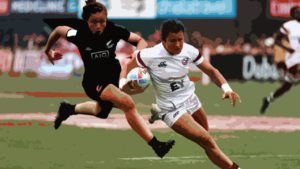How to get strong ankles for rugby season
- Patrick Dale
- Injury Prevention, Strength
If you play rugby, injuries are a fact of life. Playing and training for what is arguably one of the physically toughest sports can take its toll on your body.
While some injuries are unavoidable, contact-related injuries for example, others are less so. Many injuries can be prevented with the right prehab and conditioning.
One of the most debilitating body parts to injure is the ankle joint. Twists, sprains, and breaks can stop even the hardest charging rugger in their tracks, and keep you off your feet for days, weeks, or even months.
Avoid becoming another ankle injury statistic by boning up on this small but important joint.
Ankle anatomy 101
The ankle is an atypical hinge joint. That means it flexes and extends, properly called dorsiflexion and plantarflexion, but also inverts and everts too. The ankle is a very mobile joint, but that mobility comes at a cost: stability. The more unstable a joint is, the more likely you are to injure it.
Combine this inherent instability with supporting a lot of weight, fast changes of direction, and an often-uneven playing surface, and you have the perfect storm for ankle injuries. As the ankle “rolls over” the muscles, ligaments, and bones of the ankle joint can be damaged. While muscles tend to heal quite quickly, poor blood supply to the ligaments means that any damage can take quite a while to heal, and bones often take even longer.
In a twisted ankle, any tissue damage is very minor, and you may find you can “run off” the pain in a couple of minutes. Consider a twisted ankle to be a near miss – if the joint deviation had been greater, you would have suffered a sprain or even a break.
An ankle sprain involves damage to the ligaments of the ankle and can be mild, moderate, or severe.
- Mild/Grade I – stretching and/or minor tearing of the ligament without joint laxity (loosening)
- Moderate/Grade II – tearing of ligament plus some joint laxity
- Severe/Grade III – complete tear of the affected ligament (very loose)
All ankle sprains are invariably very painful and will mean you have to stop training or playing. Depending on the severity, you will need several days to a few weeks to fully recover.
In extreme situations, the ankle joint can break. Needless to say, in that situation playing on will be impossible, and once confirmed with an X-ray, the ankle joint will need to be set and immobilized in a cast, and you can look forward to a few weeks on crutches.
Ankle injuries – once is never enough!
One of the worst aspects of ankle injuries is that once you’ve had one, you’ll probably injure that same ankle again and again and again. This is because damaged ligaments often remain lax and that causes even more joint instability.
Additionally, the proprioceptive (sensory) nerves that tell your brain how your foot is positioned without having to look at it will also be damaged. This means your ability to sense balance changes and uneven surfaces won’t be as good as it should be, and you are more likely to place your foot incorrectly.
Because of this, ankle rehab is crucial after any sort of ankle injury. It’s not enough to just passively wait for the ankle to heal; you need to take steps to reduce your risk of re-injury. Rehab and prehab for the ankle are very similar and covered later in this article.
Treatment of ankle injuries
When an ankle injury strikes, the best initial course of action is the PRICE protocol. This will reduce swelling, inflammation, and pain, and may hasten recovery.
PRICE stands for:
Protection – stop playing to avoid making it worse
Rest – stay off the injured ankle and avoid weight-bearing activity for the next 24-48 hours
Ice – apply to the injured area (but not directly to the skin) for 20 minutes every two hours
Compression – use a compression bandage to support the injury and further control swelling
Elevation – raise the injury above heart-height to promote drainage and reduce swelling
You should also avoid drinking alcohol, hot showers, heat rubs, heat packs, and aspirin during the 24 hours after injury as they can all delay recovery by prolonging swelling and bleeding. Anti-inflammatories such as ibuprofen are acceptable.
Of course, if you suffer a broken ankle, you’ll need proper medical attention. You can’t run off a fracture! In some instances, a severe sprain can present as a broken ankle and only an X-ray will reveal the difference. If you experience a break or very severe sprain, make sure you seek medical attention immediately.
An ounce of prevention…
While some ankle injuries are unavoidable, you can reduce your chances of suffering twists and sprains by conditioning your ankles to better withstand the demands of rugby.
Ankle prehab has been shown to be an effective way to lower the risk of injury. In a 2007 study, published in the American Journal of Sports Medicine, at-risk football players did pre-season balance training to increase ankle stability and strength. In the following season, there was a significant reduction in ankle injuries. (Ref 1.)
As the old saying goes, an ounce of prevention is worth a pound of cure, and just a few minutes of ankle prehab per day could save you weeks or even months on the injury list. taping your ankles before playing or training can also help reduce injuries, as can the use of a lace-up ankle support. However, passive support is never as effective as using your own muscles to support yourself, but they may still help.
Ankle prehab
Ankle prehab is a relatively simple process of stretching and strengthening the tissues of the ankle while improving balance and stability. You should only need a few minutes per day and, as these are very low-stress exercises, they shouldn’t affect the rest of your rugby training. In fact, you should be able to do your ankle prehab at home using nothing more than a resistance band.
Do the following exercises every other day:
Calf stretch – tight calves can contribute to ankle injuries. Stretch your calves by standing on the edge of a step and allowing gravity to pull your heels down below the level of your toes. Keep your legs straight for 20-30 seconds and then bend your knees slightly for a further 20-30 seconds. If your calves are very tight, stretch one leg at a time to make better use of your bodyweight.
One leg standing – stand on one leg to improve ankle balance, stability, and proprioception. If you can do this fairly easily for 30 seconds or more, try closing your eyes to make the exercise more challenging. Standing on a cushion or foam pad will make this exercise harder still.
Single leg Romanian deadlifts – stand on one leg and then hinge forward to touch the floor in front of your feet. Extend your non-weight-bearing leg out behind you for balance. Stand up and repeat.
Tip-toe walking – this old-school bodybuilding exercise is a great way to strengthen your calves and increase ankle stability. Rise up onto your tip-toes and then walk as far as you can without letting your heels touch the floor.
Band external rotations – sit on the floor with your legs extended and a short resistance band around the balls of your feet. Without rolling your legs outward, push your feet apart against the resistance offered by the band.
Incorporating more single leg exercises into your gym workouts will also enhance balance and ankle stability. For more ankle prehab ideas, please see this free handout from the International Association of Fire Fighters.
Supplement stacks like our best-seller Ruck Recovery (Pro) can have a big impact on your training and on-pitch performance, but something as small as an ankle injury can still put you on the side-lines. Make ankle prehab a priority to reduce your risk of suffering an otherwise avoidable ankle injury.
Reference 1. The Effectiveness of a Balance Training Intervention in Reducing the Incidence of Noncontact Ankle Sprains in High School Football Players


